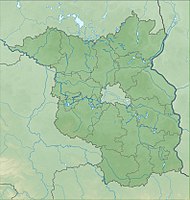Radeberge
|
Radeberge
|
||
| location | Groß Köris / Heidesee , Dahme-Spreewald district , Brandenburg , Germany | |
| surface | 289 ha | |
| Identifier | 1223 | |
| WDPA ID | 329584 | |
| Natura 2000 ID | DE3748304 | |
| FFH area | 286.09 ha | |
| Geographical location | 52 ° 12 ' N , 13 ° 41' E | |
|
|
||
| Setup date | June 16, 2004 | |
| administration | State Environment Agency Brandenburg (Department of Ecology, Nature Conservation, Water) | |
| Legal basis | Directive 92/43 / EEC | |
The Radeberge nature reserve lies on the territory of the communities Heidesee and Groß Köris in the Dahme-Spreewald district in Brandenburg . It belongs to the Dahme-Heideseen nature park .
The area with the identification number 1223 was placed under nature protection by ordinance of June 16, 2004 . The 289 hectare nature reserve with the Paddenpfuhl extends northwest of Neubrück , a residential area of the community of Groß Köris. The B 179 runs along the eastern edge of the area, to the west is the Pätzer Hintersee and the A 13 , and to the east is the Holzerne See and the Dubrow and Katzenberge nature reserves .
natural reserve
Natura 2000 and FFH areas
The Radeberge NSG is part of the coherent European ecological network of special protection areas Natura 2000 . The profile of the Federal Agency for Nature Conservation (BfN) contains the following characterization for the 286.09 hectare FFH area under the number 3748-304:
“Large-scale formation of mixed pine-oak forests with scattered, small-area occurrences of mesotrophic calcareous lakes and calcareous swamps and bogs. Profile FFH area Radeberge. "
Flora and fauna
plants
Among the habitat types, the FFH profile lists the following plant and forest communities : transitional and rocking bogs (Natura 2000 code 7140; Caricion lasiocarpae and Rhynchosporion albae ), swamps and reed beds with a cutting edge (7210; calcareous swamps with Cladium mariscus and species of Caricion davallianae ), old acidic oak forests on sandy soils with pedunculate oak (9190), bog forests (91D0) and nutrient-poor to moderately nutrient-rich calcareous still waters with chandelier algae (3140; oligo- to mesotrophic calcareous still waters with benthic chandelier algae vegetation) ( Characeae vegetation ).
Animals
According to Annex II of the Flora-Fauna-Habitat Directive and the ordinance of the state, including their habitats that are important for reproduction, nutrition, migration and wintering, are particularly protected: among the mammals the otter ( Lutra lutra ) and among the invertebrates the great oak billy ( Cerambyx cerdo ) and the stag beetle ( Lucanus cervus ).
See also
Individual evidence
- ↑ a b c 3748-304 Radeberge. (FFH area) Profiles of the Natura 2000 areas. Published by the Federal Agency for Nature Conservation . Retrieved May 19, 2020.
Web links
- World Database on Protected Areas - Radeberge (English)
- Ordinance on the "Radeberge" nature reserve of May 24, 2004 on bravors.brandenburg.de, accessed on May 19, 2020
- Radeberge on the website of the Dahme-Heideseen Nature Park

